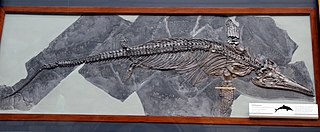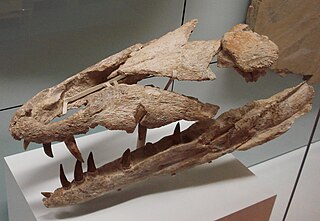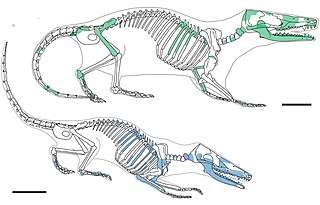
Ichthyosaurs are large extinct marine reptiles. Ichthyosaurs belong to the order known as Ichthyosauria or Ichthyopterygia.
The Early Jurassic Epoch is the earliest of three epochs of the Jurassic Period. The Early Jurassic starts immediately after the Triassic–Jurassic extinction event, 201.3 Ma, and ends at the start of the Middle Jurassic 174.7 ±0.8 Ma.

Ichthyosaurus is a genus of ichthyosaurs from the Early Jurassic, with possible Late Triassic record, from Europe. It is among the best known ichthyosaur genera, as it is the type genus of the order Ichthyosauria.

Dakosaurus is an extinct genus of crocodylomorph within the family Metriorhynchidae that lived during the Late Jurassic and Early Cretaceous. It was large, with teeth that were serrated and compressed lateromedially. The genus was established by Friedrich August von Quenstedt in 1856 for an isolated tooth named Geosaurus maximus by Theodor Plieninger in 1846. Dakosaurus was a carnivore that spent much, if not all, its life out at sea. The extent of its adaptation to a marine lifestyle means that it is most likely that it mated at sea, but since no eggs or nests have been discovered that have been referred to Dakosaurus, whether it gave birth to live young at sea like dolphins and ichthyosaurs or came ashore like turtles is not known. The name Dakosaurus means "biter lizard", and is derived from the Greek dakos ("biter") and σαῦρος -sauros ("lizard").

Temnodontosaurus is an extinct genus of ichthyosaur from the Early Jurassic period. They lived between 200 and 175 million years ago (Hettangian-Toarcian) in what is now Western Europe and possibly Chile. It lived in the deeper areas of the open ocean. University of Bristol paleontologist Jeremy Martin described the genus Temnodontosaurus as "one of the most ecologically disparate genera of ichthyosaurs," although the number of valid Temnodontosaurus species has varied over the years.

Geosaurus is an extinct genus of marine crocodyliform within the family Metriorhynchidae, that lived during the Late Jurassic and the Early Cretaceous. Geosaurus was a carnivore that spent much, if not all, its life out at sea. No Geosaurus eggs or nests have been discovered, so little is known of the reptile's lifecycle, unlike other large marine reptiles of the Mesozoic, such as plesiosaurs or ichthyosaurs which are known to give birth to live young out at sea. Where Geosaurus mated, whether on land or at sea, is currently unknown. The name Geosaurus means "Mother of Giants lizard", and is derived from the Greek Ge- and σαῦρος -sauros ("lizard"). The name Geosaurus was established by the French naturalist Georges Cuvier in 1824.

Eurhinosaurus is an extinct genus of ichthyosaur from the Early Jurassic (Toarcian), ranging between 183 and 175 million years. Fossils of the aquatic reptile have been found in Western Europe. They used to live in the deep, open sea area. Eurhinosaurus was a large genus of ichthyosaurs. An adult individual could reach up to 7 metres (23 ft) in length.

Stephen Louis Brusatte is an American paleontologist and evolutionary biologist who specializes in the anatomy and evolution of dinosaurs. He was educated at the University of Chicago for his Bachelors degree, at the University of Bristol for his Master's of Science on a Marshall Scholarship, and finally at the Columbia University for Master's in Philosophy and Doctorate. He is currently a Reader in Vertebrate Palaeontology at the University of Edinburgh.

Megalneusaurus is an extinct genus of large pliosaur that lived in the Sundance Sea during the Kimmeridgian, ~156-152 million years ago, in the Late Jurassic. It was named by paleontologist W. C. Knight in 1895.

Steneosaurus is a dubious genus of teleosaurid crocodyliform from the Middle or Late Jurassic of France. The genus has been used as a wastebasket taxon for thalattosuchian fossils for over two centuries, and almost all known historical species of teleosauroid have been included within it at one point. The genus has remained a wastebasket, with numerous species still included under the label ‘Steneosaurus’, many of which are unrelated to each other.

Arthropterygius is a widespread genus of ophthalmosaurid ichthyosaur which existed in Canada, Norway, Russia, and Argentina from the late Jurassic period and possibly to the earliest Cretaceous.

Acamptonectes is a genus of ophthalmosaurid ichthyosaurs, a type of dolphin-like marine reptiles, that lived during the Early Cretaceous around 130 million years ago. The first specimen, a partial adult skeleton, was discovered in Speeton, England, in 1958, but was not formally described until 2012 by Valentin Fischer and colleagues. They also recognised a partial subadult skeleton belonging to the genus from Cremlingen, Germany, and specimens from other localities in England. The genus contains the single species Acamptonectes densus; the generic name means "rigid swimmer" and the specific name means "compact" or "tightly packed".

Thalattoarchon is an extinct genus of large predatory ichthyosaurs that lived in the Middle Triassic (Anisian) in what is now North America, between 244.6 to 242 millions years ago. The only known species is T. saurophagis, described in 2013 from a single specimen discovered in 1997 in the Favret Formation, Nevada. The generic name, meaning "ruler of the seas", refers to its status as an apex predator, while the specific epithet, meaning "lizard eater", alludes to its carnivorous diet.

This timeline of ichthyosaur research is a chronological listing of events in the history of paleontology focused on the ichthyosauromorphs, a group of secondarily aquatic marine reptiles whose later members superficially resembled dolphins, sharks, or swordfish. Scientists have documented ichthyosaur fossils at least as far back as the late 17th century. At that time, a scholar named Edward Lhwyd published a book on British fossils that misattributed some ichthyosaur vertebrae to actual fishes; their true nature was not recognized until the 19th century. In 1811, a boy named Joseph Anning discovered the first ichthyosaur fossils that would come to be scientifically recognized as such. His sister Mary would later find the rest of its skeleton and would go on to become a respected fossil collector and paleontologist in her own right.

Temnodontosaurus eurycephalus is an extinct species of marine reptile. It is thought to have been a nektonic carnivore. Its name comes from the Greek ευρύς, for "wide" and κεφαλή for "head". It possibly belongs to a new genus.

Wahlisaurus is an extinct genus of leptonectid ichthyosaur. The holotype was found in the Scunthorpe Mudstone in Nottinghamshire in 1951 and described in 2016 by Dean Lomax. The type species is Wahlisaurus massare, and two specimens have been found: the first consisting of a skull and an incomplete skeleton, and the second a single coracoid.

Borealestes is a genus of docodontan from the Middle Jurassic of Britain, first discovered on the Isle of Skye near the village of Elgol. It was the earliest mammaliaform from the Mesozoic found and named in Scotland. A second species and was later found in other Middle Jurassic sites in England, but is now shown to be a different genus. A new species, B. cuillinensis was named in 2021, also from Skye.
Elgin Reptiles is the name given to the Permian and Triassic fossils found in the sandstone deposits in and around the town of Elgin, in Moray, Scotland. They are of historical and scientific importance, and many of the specimens are housed in the Elgin Museum, and some in the Hunterian in Glasgow, and the National Museum of Scotland in Edinburgh. The Elgin Reptiles include the dinosauriform Saltopus elginensis, the dicynodont Gordonia, and the pareiasaur Elginia. There are also many footprints and tail-drags associated with the same Permian and Triassic sandstone deposits.

Dearc is a genus of large-bodied rhamphorhynchine pterosaur from the Middle Jurassic Lealt Shale Formation of Scotland. The holotype, a juvenile or subadult that was still actively growing, has an estimated wingspan of 2.5 to 3 meters, making it the largest flying animal of its time. This pushes the origin of large pterosaurs back significantly, as it was previously assumed that pterosaurs did not reach greater body sizes until the short-tailed pterodactyloid lineages of the Cretaceous. The genus contains a single species, Dearc sgiathanach ( ).
Michael Waldman is a British palaeontologist known for his work on fossil fish, mammals, and reptiles. He also discovered the globally important fossil site of Cladach a'Ghlinne, near Elgol on the Isle of Skye, Scotland. This site exposes the Kilmaluag Formation and provides a valuable record of Middle Jurassic ecosystems. During the 1970s he visited the site several times with fellow palaeontologist Robert Savage. The fossil turtle Eileanchelys waldmani was named after Michael in recognition of his notable contribution to palaeontology.
























